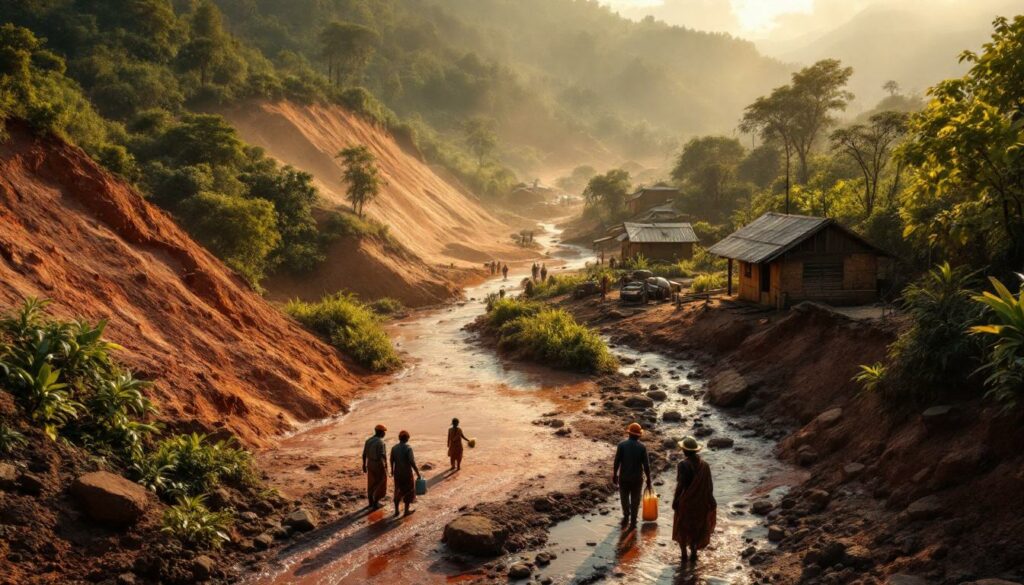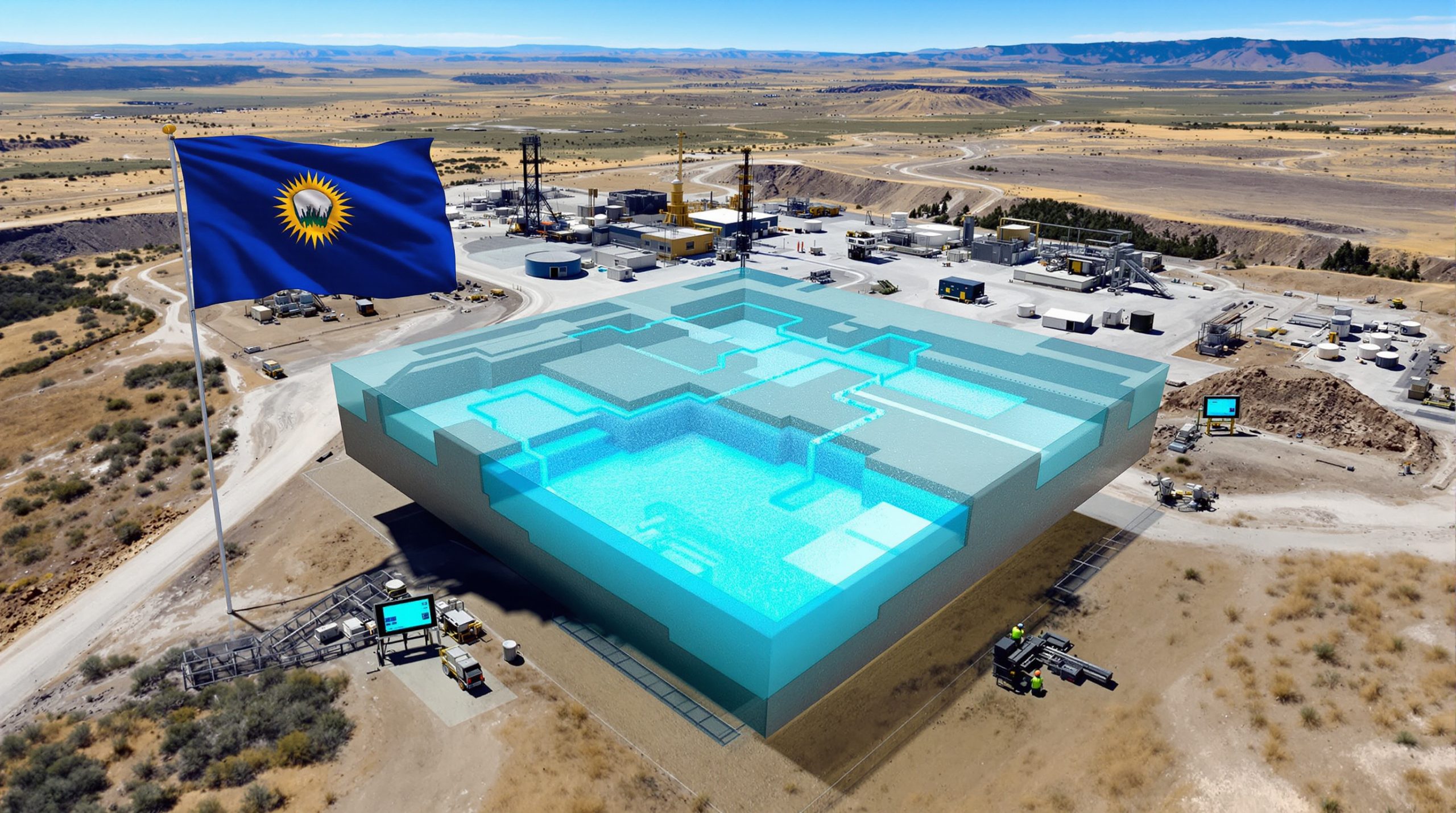Environmental Impact of Guinea's Simandou Iron Ore Project: Water and Soil Contamination Concerns
Guinea's Simandou iron ore project has come under increasing scrutiny as recent studies reveal concerning levels of water and soil pollution connected to its massive construction efforts. This developing situation highlights the tension between economic development and environmental protection in one of Africa's most significant resource extraction projects.
What Is the Simandou Iron Ore Project?
The Simandou project represents one of the world's largest untapped iron ore reserves, spanning a massive 650-kilometer corridor across southeastern Guinea. This strategically vital resource has attracted major global mining interests and billions in investment, but growing environmental concerns threaten to complicate its development timeline.
Overview of the World's Largest Untapped Iron Ore Reserve
Simandou's iron ore deposits are estimated to represent approximately 20% of global iron ore reserve potential, making it a prize asset in the international mining landscape. The project stretches across Guinea's forested highlands, requiring extensive infrastructure development including mines, processing facilities, and a 650-kilometer railway corridor connecting to a new deep-water port at Moribayah on Guinea's Atlantic coast.
The scale of Simandou is unprecedented in West Africa, with high-grade iron ore deposits (65%+ Fe content) that are particularly valuable in steel production. This quality makes the ore especially attractive to Chinese steel producers seeking to reduce reliance on Australian imports amid ongoing trade tensions.
First shipments are scheduled for November 2025, though environmental complications could potentially affect this timeline. The project's development has faced numerous delays over its decades-long history, with political instability, corruption allegations, and financing challenges all playing roles in its stop-start progression.
Key Project Stakeholders and Ownership Structure
Simandou is divided into four blocks with complex ownership structures involving multinational corporations, Chinese state-backed entities, and the Guinean government:
- Blocks 1 and 2: Controlled by Winning Consortium Simandou (WCS), a Chinese-backed venture including China Baowu Steel Group, the world's largest steel producer
- Blocks 3 and 4: Operated by Rio Tinto (holding 51%) in partnership with Aluminum Corporation of China (Chinalco) (holding 49%)
The Guinean government maintains significant stakes across all four blocks, reflecting the project's strategic importance to the national economy. For Guinea, Simandou represents a potential economic transformation, with projections suggesting it could double the country's GDP once fully operational.
The project's Chinese backing highlights its importance to China's "Belt and Road" strategy and efforts to secure raw material supply chains independent of traditional Western-controlled sources.
What Environmental Contamination Has Been Discovered?
Recent scientific analysis has documented concerning levels of contamination in both water and soil samples collected throughout the project area, raising alarms about potential long-term environmental and health impacts for local communities.
Water Pollution Findings from Recent Study
A comprehensive investigation by Advocates for Community Alternatives collected and analyzed 19 water samples along the railway corridor and mining areas, revealing troubling results:
- Elevated acidity levels making water unsafe for human consumption without treatment
- Bacterial contamination exceeding World Health Organization safety guidelines
- Visible contamination in previously pristine water sources used by local communities
- Degradation of fishing areas in the coastal Moribayah region, threatening traditional livelihoods
"The high acidity levels we found in these samples make the water unsafe for consumption without treatment," explains Kwabina Ibrahim, lead researcher with Advocates for Community Alternatives. "This poses direct threats to community health, especially for vulnerable populations like children and pregnant women."
Water pollution appears particularly severe near construction zones where blasting, excavation, and materials processing occur. Acid mine drainage—a process where exposed sulfide minerals react with water and air to create acidic runoff—is suspected as a major contributor to the contamination.
Soil Contamination Assessment Results
Parallel to water testing, 19 soil samples collected throughout the project area revealed additional environmental concerns:
- Heavy metal concentrations exceeding agricultural safety thresholds
- Acidification of previously fertile farmland
- Contamination patterns correlating with construction activity zones
- Potential long-term impacts on food security for communities dependent on subsistence farming
The soil contamination presents particular challenges for local farmers who rely on traditional agricultural practices for both subsistence and income. Several communities have reported declining crop yields in areas adjacent to construction activities, though comprehensive quantitative data on agricultural impacts remains limited.
"When mining projects contaminate soil, the effects can persist for generations if not properly remediated," notes an environmental assessment specialist familiar with West African mining operations. "The mobility of heavy metals through soil into groundwater creates a compounding problem that requires immediate intervention."
How Is Construction Affecting Local Communities?
Beyond water and soil contamination, physical infrastructure damage and disruption to traditional livelihoods have created immediate hardships for communities along the project corridor.
Documented Infrastructure Damage
Residents in several coastal settlements have reported structural damage to their homes, including:
- Wall cracks appearing in homes following construction activities
- Foundation settling issues correlating with nearby blasting operations
- Damage to community infrastructure including water collection systems
- Vibration impacts from heavy machinery and transport vehicles
Documentation efforts by local advocacy groups have established temporal connections between construction activities and the appearance of structural damage, though project developers have disputed direct causation in some cases.
The question of compensation for affected properties remains contentious, with unclear pathways for affected homeowners to seek remediation or financial compensation for damages. This situation reflects broader concerns about the project's social license to operate and community engagement approach.
Health and Livelihood Implications
The combined effects of environmental contamination and physical disruption have created cascading impacts on community health and traditional economic activities:
- Increased reports of gastrointestinal illnesses in communities using affected water sources
- Heightened vulnerability for pregnant women and children exposed to contaminated water
- Disruption of fishing grounds vital to coastal communities' protein sources and income
- Reduced agricultural productivity threatening food security and economic stability
These impacts disproportionately affect Guinea's most vulnerable populations, who often lack alternative livelihood options or the resources to relocate. Women and children bear particular burdens, as they are typically responsible for water collection and most vulnerable to waterborne contaminants.
The situation mirrors previous cases of large-scale mining developments across Africa, where initial promises of economic benefits have been undermined by environmental degradation that threatens traditional subsistence activities.
What Environmental Monitoring Systems Are in Place?
Questions about the adequacy of environmental monitoring and oversight have emerged as a central concern for both affected communities and independent observers.
Current Environmental Management Approaches
The environmental management framework for Simandou includes several formal components:
- Initial environmental impact assessments conducted before project approval
- Corporate environmental monitoring programs implemented by project developers
- Regulatory oversight by Guinean environmental authorities
- Periodic compliance reporting to international financial institutions supporting the project
However, significant gaps have emerged in the implementation and effectiveness of these systems. Critics point to insufficient baseline data collection before construction began, limiting the ability to quantitatively measure environmental changes attributable to the project.
The capacity constraints within Guinea's environmental regulatory agencies have also raised questions about the government's ability to effectively monitor such a massive project spanning hundreds of kilometers and multiple ecological zones.
Independent Verification Efforts
In response to perceived gaps in official monitoring, several independent verification initiatives have emerged:
- Advocates for Community Alternatives' community-led water and soil sampling program
- Local environmental justice groups documenting visual changes to water bodies
- International NGO monitoring of the project's compliance with international standards
- Academic research partnerships examining ecological impacts in sensitive areas
These independent efforts face significant challenges, including limited resources, access restrictions to certain project areas, and methodological constraints. Nevertheless, they have played a crucial role in bringing environmental concerns to wider attention.
"Independent environmental monitoring is essential for projects of this scale," explains Ibrahim. "When communities participate in scientifically sound data collection, it creates both accountability and opportunities for more responsive mitigation efforts."
What Remediation Measures Are Being Recommended?
As environmental impacts become more apparent, calls for both immediate interventions and long-term remediation strategies have intensified from various stakeholders.
Urgent Action Proposals
Environmental advocates and affected communities have identified several priority interventions:
- Immediate water treatment solutions for affected communities, including temporary water supply systems until contamination sources are addressed
- Construction practice modifications to reduce soil disturbance and prevent further contamination
- Emergency soil stabilization in areas showing elevated contamination levels
- Health screening programs for residents exposed to contaminated water
- Transparent disclosure of all environmental monitoring data to affected communities
These immediate actions would address the most pressing health and safety concerns while longer-term solutions are developed and implemented.
Long-Term Environmental Management Strategies
Sustainable management of Simandou's environmental impacts will require comprehensive approaches:
- Integrated water management infrastructure including treatment facilities, monitoring stations, and protected watershed areas
- Agricultural land rehabilitation programs using phytoremediation and soil amendment techniques
- Community-based environmental monitoring networks with formal recognition in regulatory frameworks
- Ecosystem restoration initiatives for damaged waterways and forests
- Climate-resilient design modifications accounting for changing rainfall patterns in the region
International mining best practices suggest these long-term strategies should be backed by dedicated environmental remediation funds with independent governance to ensure implementation continues throughout the project lifecycle.
How Does This Compare to Other Major Mining Projects?
Simandou's environmental challenges echo similar experiences in other large-scale mining developments globally, though with important contextual differences.
Environmental Performance Benchmarking
When compared to international mining operations, several patterns emerge:
| Project | Environmental Challenges | Remediation Approaches | Outcomes |
|---|---|---|---|
| Simandou (Guinea) | Water/soil contamination, structural damage | Under development | Ongoing |
| Ok Tedi (Papua New Guinea) | Severe river system contamination | $1.5B+ remediation program | Mixed results after decades |
| Panguna (Bougainville) | Watershed degradation, social conflict | Abandoned without remediation | Long-term environmental damage |
| Oyu Tolgoi (Mongolia) | Water scarcity, dust contamination | Advanced water recycling, monitoring | Improved performance after early issues |
The experiences of these comparable projects highlight both cautionary tales and potential models for improvement. Particularly relevant is the Ok Tedi case, where initial environmental oversights led to decades of contamination that ultimately required billions in remediation costs and permanent ecosystem changes.
Balancing Development and Environmental Protection
The tension between economic development and environmental protection remains central to Simandou's story:
- Guinea's legitimate development needs and the project's potential economic benefits must be weighed against environmental costs
- International standards like the IFC Performance Standards provide frameworks for responsible development, but implementation gaps remain
- Technological innovations can reduce environmental footprints, but require upfront investment
- Climate change considerations add complexity, as iron ore contributes to both carbon-intensive industries and materials needed for energy transition
The Simandou case illustrates a broader challenge facing resource-rich developing nations: how to leverage natural resources for economic development while preventing environmental degradation that undermines long-term sustainability.
What Are the Implications for Guinea's Mining Sector?
Simandou's environmental challenges have broader implications for Guinea's growing mining sector and regulatory frameworks.
Regulatory and Policy Considerations
The environmental issues at Simandou highlight several policy gaps that require attention:
- Enforcement capacity needs strengthening within Guinea's environmental protection agencies
- Environmental bond requirements should be recalibrated to reflect actual remediation costs
- Independent monitoring mandates could formalize the role of third-party verification
- Community consent processes require strengthening to ensure informed participation
- Transparent reporting requirements would improve accountability to affected populations
These regulatory enhancements would benefit not only Simandou but Guinea's entire extractive sector, which includes bauxite, gold, and diamond mining operations facing similar environmental challenges.
Future of Sustainable Resource Development
Looking forward, Guinea's approach to Simandou could establish precedents for more sustainable resource development:
- Integrated planning approaches that consider cumulative impacts across multiple projects
- Community benefit-sharing models ensuring local populations receive tangible advantages
- Climate-resilient infrastructure design accounting for changing environmental conditions
- Biodiversity conservation offsets protecting equivalent ecosystems elsewhere in Guinea
- Technology transfer initiatives building local capacity for environmental management
The stakes extend beyond Guinea, as Simandou represents a test case for whether large-scale resource extraction can proceed in environmentally responsible ways that benefit host countries while meeting global demand for raw materials. Furthermore, the implementation of effective waste management solutions will be crucial for minimizing environmental damage.
FAQs About Simandou's Environmental Impact
What specific contaminants were found in the water samples?
The water samples collected along the Simandou project corridor revealed several concerning contaminants:
- Increased acidity (pH levels below WHO drinking water guidelines)
- Bacterial contamination including coliform bacteria indicating fecal contamination
- Suspended solids resulting from construction runoff and erosion
- Potential heavy metals including aluminum and manganese mobilized by acidic conditions
These contaminants can cause both acute health effects (gastrointestinal illness from bacterial exposure) and chronic health issues (developmental impacts from heavy metal exposure). The WHO drinking water guidelines establish safety thresholds that were exceeded in multiple sample locations.
How are local communities being compensated for environmental damage?
Current compensation mechanisms for environmental impacts remain largely underdeveloped:
- No systematic compensation program for contaminated water sources has been documented
- Property damage claims follow inconsistent evaluation processes
- Agricultural losses from soil contamination lack standardized valuation methods
- Long-term health impact compensation frameworks are absent
International standards suggest companies should provide both remediation of environmental damage and compensation for interim losses until environments recover. Guinea's mining code includes provisions for community development funds, but these are not specifically designed to address environmental damages.
What responses have project developers provided to these findings?
Project developers have responded to environmental concerns with varying approaches:
- Public statements emphasizing their commitment to environmental standards
- Disputes over the methodology and conclusions of independent studies
- Commitments to review environmental management practices
- References to existing environmental management plans and monitoring programs
However, detailed technical responses addressing specific contamination findings have been limited. Stakeholders have called for greater transparency in environmental data sharing and more collaborative approaches to addressing identified problems.
How might these environmental issues affect the project timeline?
The environmental challenges could impact Simandou's development timeline in several ways:
- Regulatory interventions might require additional mitigation measures before construction can continue
- Remediation requirements could divert resources from construction activities
- Community opposition based on environmental concerns might create operational delays
- International financiers might withhold funding pending resolution of environmental issues
- Reputational concerns could affect partnerships and supply agreements
The scheduled first shipment in November 2025 represents an ambitious timeline that could face pressure if environmental issues require significant additional mitigation efforts or regulatory responses. In some cases, serious environmental concerns have led to halted mining project examples elsewhere in Africa.
Guinea's Simandou construction linked with water and soil pollution represents a critical test case for how major mining operations balance economic development with environmental protection. The industry trends and innovation in sustainable mining practices will be crucial to determining whether projects like Simandou can operate without causing permanent environmental damage. Additionally, the growing importance of mine reclamation importance and in-situ leaching benefits highlight alternative approaches that could minimize environmental impacts in future resource extraction projects.
Disclaimer: This article presents findings from recent environmental studies and stakeholder reports regarding the Simandou project. Environmental conditions may change, and remediation efforts may address issues identified in this analysis. Readers should consult updated information from project developers, regulatory authorities, and independent monitoring organizations for the most current status of environmental conditions.
Want to Stay Ahead of the Next Major Mining Discovery?
Discover significant ASX mineral findings before the broader market with Discovery Alert's proprietary Discovery IQ model, turning complex mineral data into actionable insights. Explore why major discoveries like the ones mentioned can generate substantial returns by visiting the Discovery Alert discoveries page and begin your 30-day free trial today.




